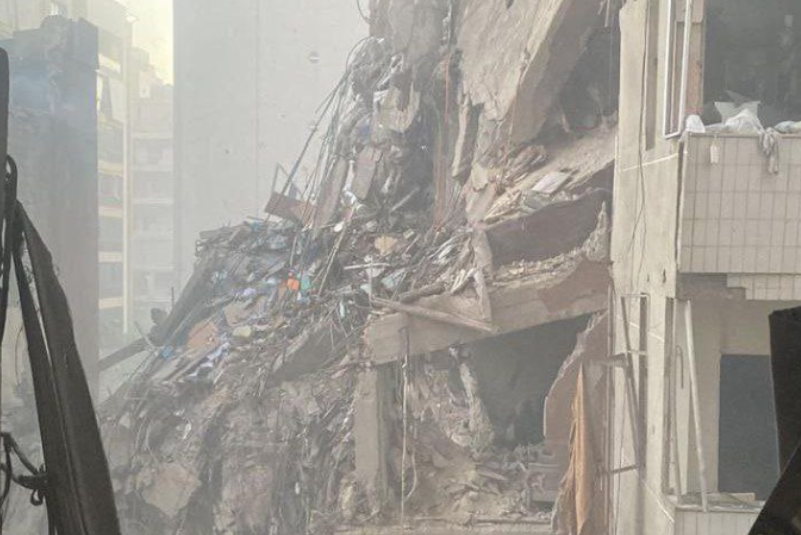Israel’s elimination of Shukr was a calculated attempt by Israel to deliver a stinging blow to Hezbollah while maintaining Gaza as its primary focus.
By Yaakov Lappin, JNS
The assassination in Beirut on Tuesday of Fuad Shukr, aka Sayyid Muhsan, Hezbollah’s chief of staff and most senior military commander, represents a strategic blow to the terrorist organization.
This targeted strike, carried out by the Israeli Air Force in Hezbollah’s Dahiya hub, highlights both Jerusalem’s advanced intelligence and firepower capabilities.
However, the critical question remains: Will Hezbollah now escalate the situation into a full-scale conflict—one that Israel is clearly seeking to avoid?
As a close adviser to Hezbollah Secretary-General Hassan Nasrallah and a member of Hezbollah’s Jihad Council, Shukr played a pivotal role in directing Hezbollah’s military operations.
He was responsible for orchestrating numerous attacks against Israel, including the July 27 rocket strike on Majdal Shams, which killed 12 children.
Shukr’s elimination is a clear message from Israel that it will not tolerate such heinous acts.
It is also a message to Nasrallah, who attempted to deter Israel from striking in Beirut, that if Israeli red lines are crossed, nowhere in Lebanon is the terror group immune.
Since joining the organization in 1985, Shukr held several senior positions, ultimately rising to lead Hezbollah’s Strategic Unit.
This unit is responsible for managing Hezbollah’s advanced weaponry, including precision-guided missiles, cruise missiles, anti-ship missiles, long-range rockets, and UAVs.
His foundational role made him a crucial figure in planning and executing terror attacks against Israel.
The Jihad Council, in which Shukr was prominent, is responsible for all of Hezbollah’s military and security activities and is subordinate to the Shura Council, the terror group’s supreme decision-making body, according to the Alma Center, which specializes in the Lebanese and Syrian arenas.
The Jihad Council is the general staff of Hezbollah’s army, and is composed mostly of senior military officials, and is under the direct supervision of Nasrallah.
In the 1990s, Shukr fought against the Israel Defense Forces and South Lebanese Army in southern Lebanon.
In 2000, he played a direct role in the abduction and murder of three IDF soldiers who were on patrol near Mount Dov.
Since then he planned and implemented many attacks on Israeli civilians.
Despite the elimination of such a high-profile target in Lebanon, Israel wished to remain focused on the Gaza Strip, where the IDF continues to fight against Hamas, which still holds 115 hostages.
IDF Spokesperson Rear Adm. Daniel Hagari said on Wednesday morning that the military remains committed to creating conditions for their return and to dismantling Hamas.
Although the IDF Home Front Command issued no immediate changes to its instructions following the Beirut strike, the IDF emphasized the need for public vigilance and the ongoing assessment of the situation.
Israel’s air defense systems are robust but not impervious, and the need for public awareness and preparedness is clear, according to the military.
Ultimately, Hezbollah’s use of a Falaq-type Iranian rocket in Saturday’s deadly rocket attack on the Golan Heights marked a severe escalation, necessitating a formidable Israeli response.
The targeted elimination of Shukr was that response, although it will not fundamentally change the security situation in northern Israel.
Only a full-scale war, which would likely last months and see Israel hit with many thousands of rockets, mortars, drones and precision guided missiles, as well as an aggressive Israeli ground maneuver in Southern Lebanon, would accomplish that.
In such a scenario, the IAF would need to strike at least 3,000 targets a day in Lebanon—an unprecedented Israeli use of airpower.
And Iran could well become directly involved, placing Washington in a strategic dilemma.
In such a conflict, the Iran and Syria fronts would likely be fully activated, posing additional challenges.
Tens of thousands of Shi’ite militia members, under the command of the Iranian Revolutionary Guards Corps (IRGC), are already operating in Syria, as is Hezbollah.
These forces would likely launch ballistic missiles, cruise missiles and UAVs at Israel, further complicating such a war scenario.
Israel is in continuous dialogue with the United States and CENTCOM, Hagari confirmed in his statement on Wednesday.
While Israel aims to avoid a broader conflict, it is fully prepared for one, according to Hagari. Yet the decision to escalate now rests with Hezbollah and Nasrallah.
One way or the other, the residents of northern Israel, some 60,000 of whom remain displaced since Oct. 8 due to ongoing Hezbollah attacks, cannot remain in limbo forever.
Looking ahead, there are two main possibilities. The first is that Hezbollah in its response to the Beirut strike sparks a war.
The second is that it chooses to respond but stays beneath the threshold of war, and then returns to regularly firing on the north as part of its strategy to force Israel into surrender in Gaza.
Should a ceasefire be reached with Hamas in Gaza, leading Hezbollah to enter into an informal truce. However, this would only delay a war, not prevent one.
Israel’s elimination of Shukr was a calculated attempt by Israel to deliver a stinging blow to Hezbollah while maintaining Gaza as its primary focus.
Nasrallah’s next steps will determine whether or not Lebanon becomes the new primary front in the fateful conflict between Israel and Iranian-backed jihadist armies.


